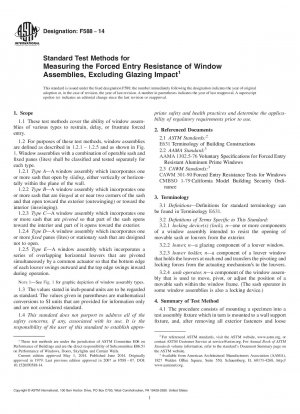ASTM F588-14
Standard Test Methods for Measuring the Forced Entry Resistance of Window Assemblies, Excluding Glazing Impact
- Standard No.
- ASTM F588-14
- Release Date
- 2014
- Published By
- American Society for Testing and Materials (ASTM)
- Status
- Replace By
- ASTM F588-17(2017)
- Latest
- ASTM F588-17(2023)
- Scope
5.1 These test methods are intended to establish a measure of resistance for window assemblies subjected to attacks (other than impacting glazing materials) by unskilled or opportunistic burglars. Resistance to higher levels of force generated by skilled burglary attack requires methods such as alarms, communication, or apprehension systems, or special security glazing materials more sophisticated than those evaluated by these test methods. Technicians performing the test should understand the intent of this test method and should be trained on the execution and pass/fail criteria.
5.2 Entry through a window assembly can be accomplished by impacting the glazing materials. This method does not evaluate glazing materials for breakage. Other standards must be used to evaluate forced entry by impacting the glazing.
5.3 Acceptance criteria for performance levels are a matter for authorities having specific jurisdiction to establish. Suggested guidelines are found in Annex A1.
1.1 These test methods cover the ability of window assemblies of various types to restrain, delay, or frustrate forced entry.
1.2 For purposes of these test methods, window assemblies are defined as described in 1.2.1 – 1.2.5 and as shown in Fig. 1. Window assemblies with a combination of operable sash and fixed panes (lites) shall be classified and tested separately for each type.
 FIG. 1 Typical Window Types (viewed from the exterior)
FIG. 1 Typical Window Types (viewed from the exterior)1.2.1 Type A—A window assembly which incorporates one or more sash that open by sliding, either vertically or horizontally within the plane of the wall.
1.2.2 Type B—A window assembly which incorporates one or more sash that are hinged at or near two corners of the sash and that open toward the exterior (outswinging) or toward the interior (inswinging).
1.2.3 Type C—A window assembly which incorporates one or more sash that are pivoted so that part of the sash opens toward the interior and part of it opens toward the exterior.
1.2.4 Type D—A window assembly which incorporates one or more fixed panes (lites) or stationary sash that are designed not to open.
1.2.5 Type E—A window assembly which incorporates a series of overlapping horizontal louvers that are pivoted simultaneously by a common actuator so that the bottom edge of each louver swings outward and the top edge swings inward during operation.
Note 1—See Fig. 1 for graphic depiction of window assembly types.ASTM F588-14 Referenced Document
- ASTM E631 Standard Terminology of Building Constructions
ASTM F588-14 history
- 2023 ASTM F588-17(2023) Standard Test Methods for Measuring the Forced Entry Resistance of Window Assemblies, Excluding Glazing Impact
- 2017 ASTM F588-17(2017) Standard Test Methods for Measuring the Forced Entry Resistance of Window Assemblies, Excluding Glazing Impact
- 2014 ASTM F588-14 Standard Test Methods for Measuring the Forced Entry Resistance of Window Assemblies, Excluding Glazing Impact
- 2007 ASTM F588-07 Standard Test Methods for Measuring the Forced Entry Resistance of Window Assemblies, Excluding Glazing Impact
- 2004 ASTM F588-04 Standard Test Methods for Measuring the Forced Entry Resistance of Window Assemblies, Excluding Glazing Impact
- 1997 ASTM F588-97 Standard Test Methods for Measuring the Forced Entry Resistance of Window Assemblies, Excluding Glazing Impact

Copyright ©2024 All Rights Reserved